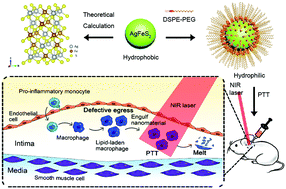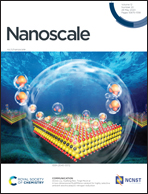AgFeS2 nanoparticles as a novel photothermal platform for effective artery stenosis therapy†
Abstract
Ternary I–III–VI2 semiconductors usually have narrow band gaps and large absorption coefficients arising from the unique characteristics of their outer-d valence electrons, which are intimately connected with the photothermal conversion properties. AgFeS2 is known as one such material that has the potential to absorb near-infrared light. In this work, we utilized density functional theory (DFT) calculations to evaluate the electronic structure and optical absorption properties of AgFeS2. Strong absorptions were predicted over a wide Vis-NIR region due to the localized 3d electron of Fe atoms, which agree quite well with the UV-Vis-NIR spectra measured by experiment. The as-prepared AgFeS2 nanoparticles were then modified with mPEG-DSPE, an efficient photothermal agent for artery stenosis therapy. Its photothermal conversion effect has been systematically studied, indicating the potential for causing the hyperthermia of macrophages, an essential part of the artery inflammation response. More importantly, both in vitro cell experiments and in vivo mouse-model studies show that the induction of hyperthermia in artery stenosis by using AgFeS2 nanoparticles is safe and effective when injected at a very low concentration. This study provides a novel photothermal platform derived from the inheritability of bandgap structure and also promotes the process of artery inflammation and stenosis therapy.



 Please wait while we load your content...
Please wait while we load your content...